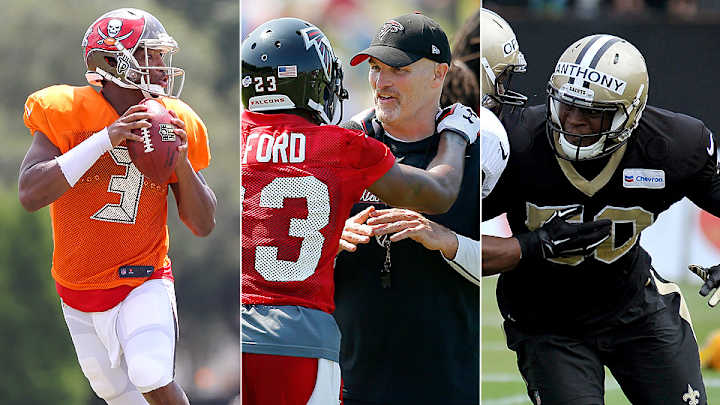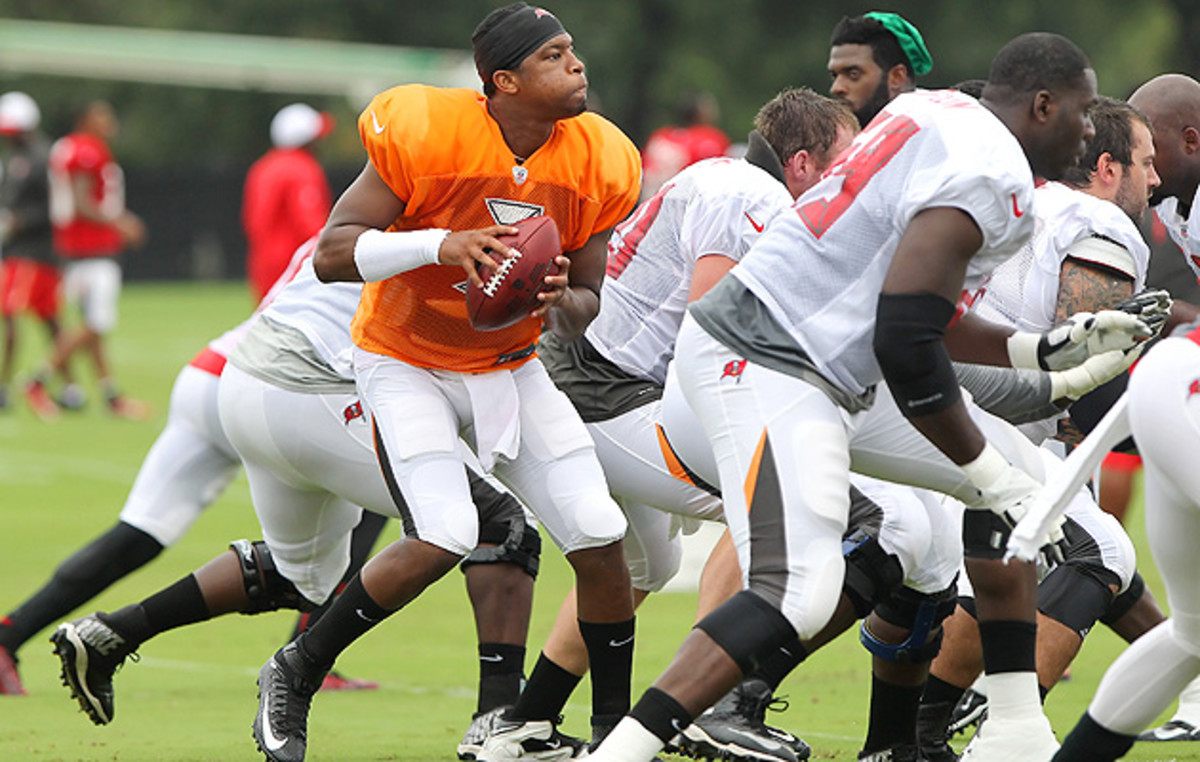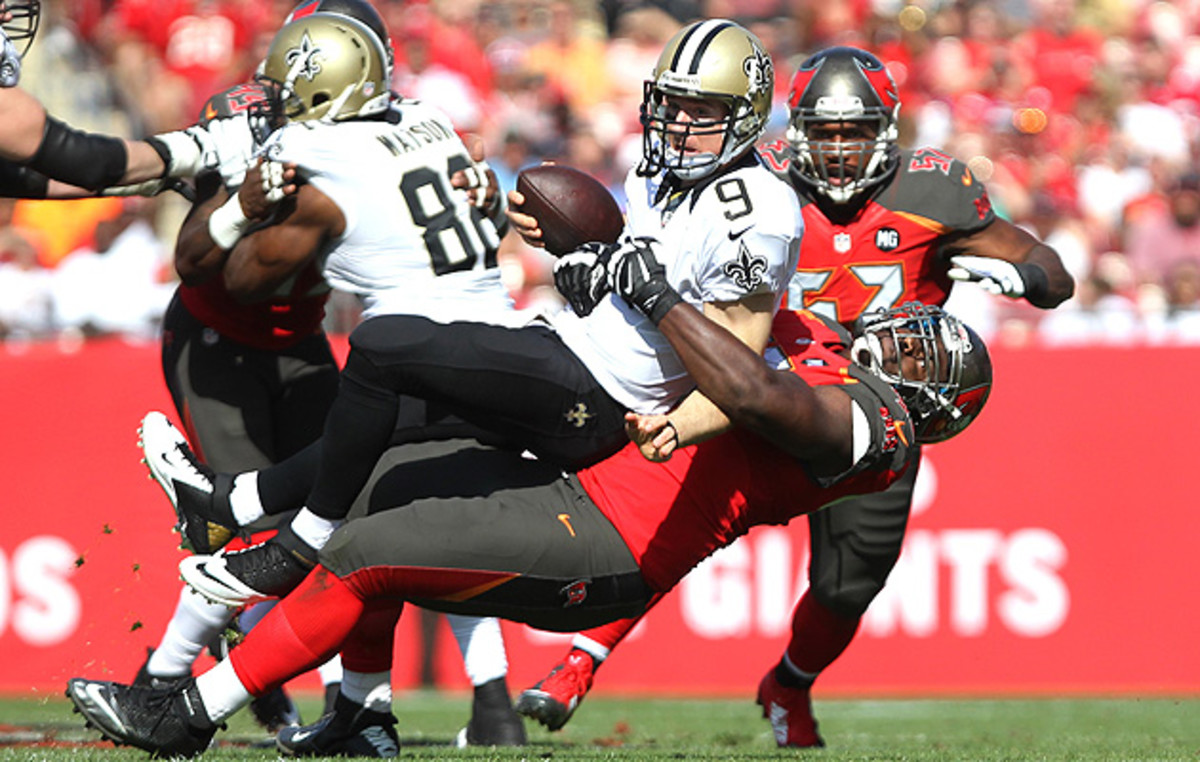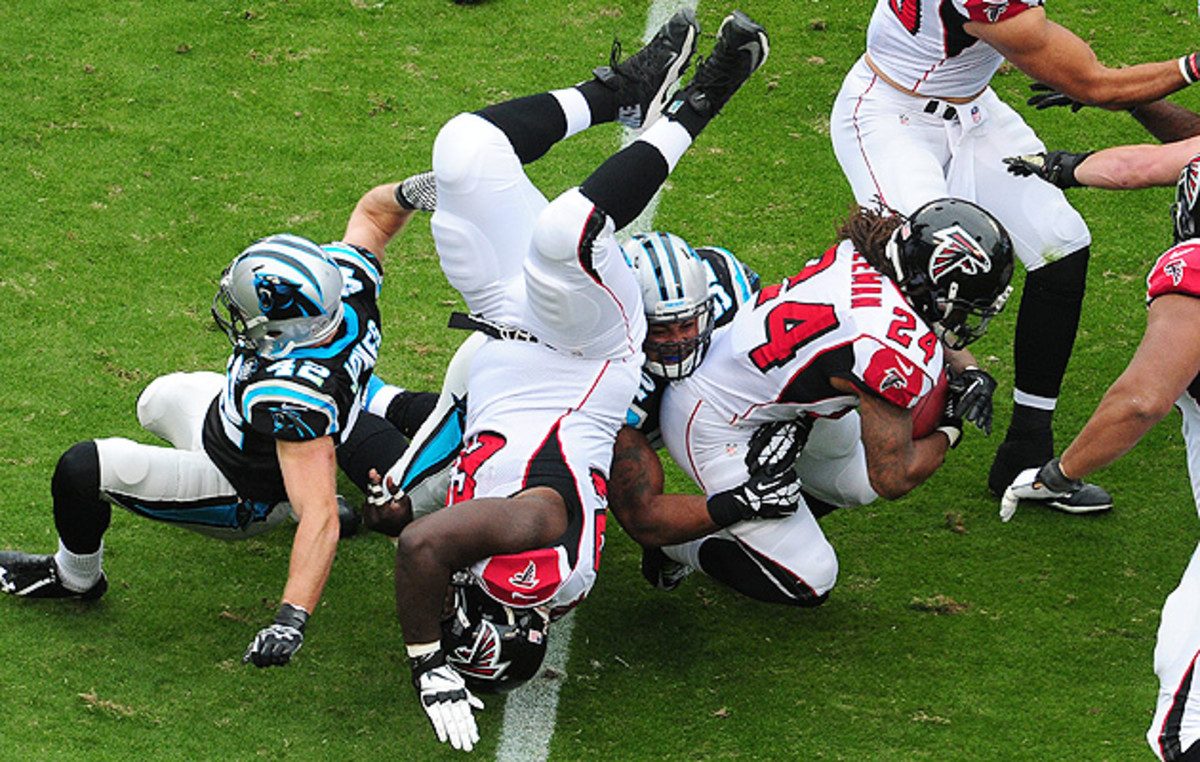NFC South challengers eye rebound after season of historic lows

Dan Quinn’s brand-new office overlooks the Falcons’ practice fields, and not a week into training camp, the place is outfitted with the trappings of the coach’s outlook. It’s tidy, organized, a little new age and definitely comfortable. If it could talk, it would tell you all about how totally great things are, and it would mean it. On the east-facing wall of the room hangs a framed poster, which quotes a sermon by pastor Charles Swindoll. “We cannot change our past,” it reads. “We cannot change the fact that people will act in a certain way. We cannot change the inevitable. The only thing we can do is play on the one string we have, and that is our attitude.”
On another wall, next to the obligatory dry erase board, two black-and-white clocks are the main décor. One is slightly larger than the other, and instead of numbers, their faces bear letters. Now, Now, Now – 12 “Nows” in total. The things are ticking clichés, but Quinn believes in this “power of the moment” business. In fact, he believes in a lot of things, about camaraderie and team and individuality, but he isn’t loud about them. His platform is in the décor and delivery and aura—yes, aura, according to veteran receiver Roddy White—as much as it is in his words, although those, too, strike a chord.
“Uniqueness is kind of the fun part of being on the team,” Quinn explains. “Let’s make sure our uniqueness never gets in the way of how tight we are as a team. If you have a different belief than I do, that’s cool to have that, but we still have the team.”
Quinn lives his methods; he doesn’t have to sell them, and he brims with a quiet, contained intensity. “You don’t get it until you’re out there around him,” Falcons quarterback Matt Ryan says. “What you see is what you get. He’s into it every day. He genuinely cares. He’s very inclusive.” Hell, maybe the Falcons’ new coach should run for president—except where would the NFC South be without him?
Legion of Boom's new look: Seahawks getting creative with their secondary
When Atlanta hired the former Seahawks defensive coordinator in December, it was the first positive news any team in the division had made since the Saints were widely projected as Super Bowl contenders—and then went 1–3 to open the year. But no team in the division started much stronger; Atlanta began with a 2–1 record before dropping five straight, Tampa Bay opened with three consecutive losses and Carolina, after going 3-2-1 through Week 6, went on a six-game midseason losing binge.
All that is to say: The 2014 NFC South was the worst division football has seen in years, if not ever. When the Panthers won a postseason spot after going 7-8-1, they became the second team in NFL history to make the playoffs with a sub-.500 record after a full season. (The other was the 7–9 2010 Seahawks.) In addition, the division as a whole—the Saints finished 7–9, the Falcons 6–10 and the Buccaneers 2–14—had a collective .352 winning percentage, worse than any other in history save the 2008 NFC West, which went .344 but still managed to boast a winning team, the 9–7 Cardinals.
• The MMQB training camp tour blog: Follow as we visit every team
“I’d be lying if I didn’t say it was bizarre,” Buccaneers general manager Jason Licht says. He recalls lamenting his team’s losing streak with an eye to the division’s mind-boggling standings. “Well, then, we’re still only X amount of games out,” he would think each week. Looking back, he can’t help but laugh.
But as the coaching carousel began in late December, Mike Smith in Atlanta was the only NFC South coach dismissed, and despite its record, Carolina kept its operation largely steady. Still, New Orleans and Tampa Bay made adjustments around their embattled coaches, and the division’s bottom three teams have each undergone major changes since they last touched cleats to turf. Questions remain: Is Jameis Winston too green? (Maybe.) Is Drew Brees too old? (Maybe not.) Will Atlanta become some makeshift Seattle East? (Not if Quinn has anything to say about it.) And why exactly did the Panthers think so few tweaks were necessary? (Certainly their division title didn’t provide that much reassurance.)

Oddly enough, it hasn’t been long since it took a great team to make the postseason in the NFC South. In 2011, the Saints won 13 games, the Falcons 10, both making the playoffs, and in '10 the South boasted three double-digit win teams; the 10–6 Bucs missed the postseason entirely. Consider that squad, quarterbacked by Josh Freeman and with LeGarrette Blount and Mike Williams powering the offense. It would likely have pushed the 2014 Panthers out of the playoffs.
Still, Carolina had a quiet off-season, and in doing so, it seems to be the bystander in a division where other front offices are willing to throw open their wallets and shuffle their personnel at major positions to avoid repeat performances. Each team is doing it in different ways, though: The Bucs foundered their way into Winston, the Saints overhauled their roster and culture, and the Falcons brought in a new coaching staff and outlook.
SI's All-Prove It Team: Players under pressure to shine in 2015
The Buccaneers are perhaps the team most flummoxed by what transpired in 2014. “None of us had undergone anything like that,” coach Lovie Smith says. “A 2–14 first year? No.” Neither Smith nor Licht would have imagined a season ago that they’d wind up with the No. 1 pick, but with a desperate need for a quarterback—the tandem of Mike Glennon and Josh McCown combined for 20 interceptions and averaged 226 yards per game a year ago—there’s a sense that the team’s struggles were for something. After all, Tampa Bay’s defense, which boasts All-ProsGerald McCoy and Lavonte David, was never supposed to be as bad as it was (it ranked 25th in total yards), nor was its offensive line, which allowed 52 sacks despite adding three veteran free agents: Logan Mankins, Anthony Collins and Evan Smith. “We thought we were close,” Smith says of his outlook a year ago.
• Fantasy football top 300 | POSITION PRIMERS: QB | RB | WR | TE | K | D/ST
In 2015, Tampa’s defense is anything but remade. It still appears to lack a pass rush, but Licht says the additions of linebackers Bruce Carter and Kwon Alexander (a fourth-round pick in this spring's draft) and safety Chris Conte will add an element of speed. The Bucs' offensive line, though, has seen major reshuffling, most notably the addition of two second-round picks, guard Ali Marpet and tackle Donovan Smith, both of whom could start.
Which brings us to Winston, of course. It’s too early to analyze his on-field performance; a good day at training camp does not a Pro Bowler make, although Mankins says he’s impressed with the rookie’s ability to read the field. Around the Bucs facility, he’s earning rave reviews. McCoy, who arrives before 7 a.m., says “the Kid” is already in at that hour working on his conditioning, and he stresses that though Winston is Tampa Bay’s biggest name, he certainly isn’t its leader. “He’s not there yet,” McCoy says. “All we want him to be is himself. We’ve got guys to lead. He’s being a rookie. He’s doing what’s necessary. That’s it. It’s our job to keep him at bay and to make sure he’s as comfortable as possible.”

Saints offensive tackle Zach Strief has no interest in sugarcoating his team’s 2014. It was messy, in the locker room and on the field. But despite finishing 7–9, New Orleans wasn’t eliminated from the race until Week 16, and Strief can imagine an alternate ending: Win that game, clinch the division, beat an ailing Cardinals team, just as the Panthers ended up doing … “It was better off losing the last game to go to the playoffs than it was going,” Strief says. “If you go … and you win, you go, hey, we were this close. And you weren’t.”
Saints looking to return to their roots after disappointing campaign
After last season, Strief and other veterans realized their team needed to look back to be educated about how the current regime built its success from nothing. Nine years after Brees and Sean Payton turned a perennial loser into a contender, the highest profile faces of the Saints remain largely the same, which is how no one noticed the team was getting younger, maybe a little bit entitled and certainly clueless as to the system upon which its success was built. It took a losing skid to see that, and now Brees, Strief, Benjamin Watson and other vets are getting a little louder, a little more dogged. They’re returning to 2006, they say, to the roots of the program. “Every guy on this team has not heard that speech, that story or that lesson before,” Brees says, “so you almost have to kind of rewind and start back over.”
• KLEMKO: Stars of Saints' 2006 draft class still around 10 years later
But what’s afoot in New Orleans goes beyond a culture change. After the team’s 2013 defensive resurgence went up in smoke, Payton and general manager Mickey Loomis brought in Dennis Allen (who was an assistant in New Orleans from 2006 to '10) as a senior defensive assistant. And despite the ambiguity of Allen’s title, it’s clear he’ll inherit plenty of control while Rob Ryan remains coordinator, and the two better play nice with their somewhat unconventional power share. “It is going to play out well,” Payton says of the relationship. “I don’t expect it to; it will.”
Other changes came with far more fanfare than Allen’s hiring. In March, Loomis dealt All-Pro tight end Jimmy Graham to Seattle for veteran center Max Unger and a first-round pick. The move stunned teammates—“Thank goodness no reporter called me that day,” Strief says—but as the spring progressed and the shock wore off, players came to accept it. Not only will the return boost the offensive line, but it also brought help for the New Orleans defense. Loomis used Seattle’s pick on linebacker Stephone Anthony, who figures to play even bigger role after the team cut outside linebacker Junior Galette in July after allegations of violence surfaced. No matter the production drop-off, parting ways with Galette looks a lot like addition by subtraction, and though the same can’t be said for Graham, if second-year receiver Brandin Cooks can develop into a true No. 1, New Orleans might be able to walk away improved from its rollercoaster of an off-season.

Despite a new franchise quarterback and a departed top tight end elsewhere in the division, the NFC South team that entered training camp looking the least recognizable plays its games at the Georgia Dome. Although the Falcons return more starters than anyone in the division (17, compared to 15 in Carolina, 13 in Tampa Bay and 11 in New Orleans), spend 30 seconds at their training camp, and you’ll notice the changes. The music pumps, rap and EDM and everything else the average player listens to on his ride home. Coaches are involved, ducking into formations to tweak positioning or hand placement. Quinn has even been known to hop into a defensive drill and make adjustments or to participate in a quick conditioning session.
SI's All-Breakout Team: Players ready to step into NFL spotlight in 2015
In theory, it sounds a lot like Seattle, with fewer All-Pro defenders and a more dynamic passing game. But Quinn shudders at that simplification; since his first interview with Falcons owner Arthur Blank and general manager Thomas Dimitroff, he’s made it clear that he’s his own man. Yes, he learned from Pete Carroll, but he also derives his coaching style from Steve Mariucci and Nick Saban, both of whom he’s worked under. Plus, the first-time head coach knew he didn’t need a complete cultural overhaul in Atlanta; the team saw consistent success under Smith for half a decade, and he was impressed by several elements of the team once he was hired. Chief among them was the athletics performance department, which is one of the few in pro sports led by a trainer who’s also a physical therapist. Without a second thought, Quinn kept the operation intact. In his profession, he says, there’s one line he hates: “This is how I’ve always done it.”
Still, between those two-hour, high-octane practices and the new methods of training—including off-season boxing and regular pickup basketball sessions—the coach has introduced, veterans in Atlanta have copped to feeling like rookies. Matt Ryan, entering his eighth season, now spends his late-summer mornings scouring his schedule. “If you’re with a head coach so long, Wednesday, you’re doing this,” he says. “Thursday, you’re doing this. Now I’ve got to be here at this [different] time, got to be early for this. I feel younger in that way.”
2015 Fantasy Football preview: Rankings, sleepers, profiles and more
Under new coordinator Kyle Shanahan, Ryan faces a different batch of changes. During Atlanta’s recent skid, its offense remained among the NFL’s top 10 but stagnated with no running game to be seen. To counteract that, Shanahan implemented his zone-blocking scheme, tweaked to accommodate Ryan’s arm and Julio Jones and White lining up wide, which should give Atlanta a refreshed look come September with Devonta Freeman as the No. 1 back. And on the opposite side of the ball, between an influx of new players and Quinn’s focus on speed, aggression and creating takeaways, the product is almost unrecognizable—which is a good thing. First-round pick Vic Beasley should energize a lacking pass rush, and second-round cornerback Jalen Collins may very well develop into a star. In addition, the team brings back safety William Moore, who was injured last season, and added linebacker Brooks Reed and defensive end Adrian Clayborn in free agency.
Dimitroff believes his team has enough to contend for a playoff spot come winter, and although that’s every general manager’s canned line in August, there’s some truth to his statement. Atlanta had a problem—defense—and addressed it without overhauling the thing it’s always done well. Under Quinn, the Falcons have perhaps the clearest path to the top of the division, although if anyone learned anything from a year ago, it’s that predictions are useless. Any of the four starting quarterbacks could get injured. The Saints offense could collapse without Graham, and the Buccaneers could have major issues along both lines. The Falcons could take time to adjust to Shanahan's offense, and Carolina might be no better and no worse than a year ago, which is to say no threat at all. But one thing is clear: This division should no longer be the NFL’s laughingstock, and it certainly won’t be a place where an eventual 2–14 team still has a playoff prayer come December.
